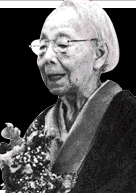- Nogami Yaeko
Infobox Writer
name = Nogami Yaeko

caption = Nogami Yaeko
birthdate = birth date|1885|5|6|df=y
birthplace =Usuki, Ōita ,Japan
deathdate = death date and age|1985|3|30|1885|5|6|df=y
deathplace =
occupation = Writer
genre = novels
movement =
notableworks =
influences =
influenced =nihongo|Yaeko Nogami|野上弥生子|Nogami Yaeko (
6 May 1885 -30 March 1985 ) was thepen-name of a novelist inShowa period Japan . Her maiden name was Kotegawa Yae.Early life
Nogami was born in
Usuki, Ōita ,Oita prefecture as the daughter of a wealthy "sake " brewer. She was taught at home by private tutors, includingKubo Kaizo , who introduced her to classicChinese literature , classicJapanese literature and taught her the art of writing "tanka" poetry. She met the novelistKinoshita Naoe , who persuaded her to enter theMeiji Jogakko , a Christan-orientated girls’ school inTokyo . While a student in Tokyo, she met Nogami Toyoichiro, a student ofNoh drama andEnglish literature underNatsume Sōseki . They were married in 1906, but she continued to work towards literary recognition. Her first published work was a short story "Enshi" ("Ties of Love") in theliterary magazine "Hototogisu " in 1907.Literary career
In the 1910, Nogami submitted poems and short stories to the mainstream
literary journal "Chuo Koron ," "Shincho", and to the feminist magazine "Seito", and gained a substantial following with fans of theproletarian literature movement . She maintained a correspondence with fellow women writersYuasa Yoshiko andMiyamoto Yuriko , with whom she shared the sentiment that literature must serve a purpose towards increasing morality and social activism. In 1922, she published "Kaijin maru" ("The Neptune", tr. 1957), a shocking semi-factual account of four men in the crew of a wrecked fishing boat, who must struggle with the choice of starvation orcannibalism .Nogami started to explore
historical fiction in the 1920s, with "Oishi Yoshio", a story about one of theForty-seven Ronin in 1926.As the Japanese government turned increasingly toward
totalitarianism and it appeared that war was growing inevitable, she and her husband traveled toEurope where they witnessed the outbreak of Spanish Civil War and ominous signs that would lead up to World War II. They returned to Japan prior to the outbreak of WWII, and she concentrated on her writing. In the post-war period, she resumed her contacts with Miyamoto Yuriko, and joined her in the foundation of the "Shin Nihon Bungakukai".Her postwar output was prolific and varied, including "Hideyoshi to Rikyu" ("Hideyoshi and Rikyu", 1962-1963), in which she explores the relationship between artist and patron (in this case
Toyotomi Hideyoshi andSen no Rikyu ). The novel was adapted into the film "Rikyu" by Japanese directorHiroshi Teshigahara .ee also
*
Japanese literature
*List of Japanese authors External links
* [http://www.usuki-kanko.com/tanosimu/nogami/yaeko.html Nogami Yaeko Memorial Museum site (Japanese)
References
* Copeland, Rebecca. "The Modern Murasaki, Writing by Women of Meiji Japan". Columbia University Press (2006). ISBN 0-231-13774-5
Wikimedia Foundation. 2010.
